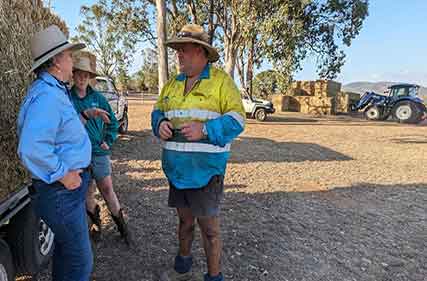 Calls to counselling services offered by the Rural Aid charity have almost doubled in the past year as drought, bushfires and low stock prices combine to cause heartbreak in the bush.
Calls to counselling services offered by the Rural Aid charity have almost doubled in the past year as drought, bushfires and low stock prices combine to cause heartbreak in the bush.
Hundreds of fires have burnt throughout Queensland over the past few weeks, razing pasture essential to farmers trying to hold on to stock while prices dive.
In the Northern Territory, about 13 million hectares have been burnt. Since June, Rural Aid has dropped 1200 tonnes of fodder, in the form of 3000 hay bales, to farmers struggling to feed their stock.
The Queensland government forked out for a further 360 bales to go to farmers whose paddocks were stripped by fires in October and this month.
Patchy rain across southern Queensland and eastern NSW last weekend brought a brief reprieve, dousing fires and replenishing water tanks.
But Rural Aid chief executive John Warlters said it was likely the tough times, driven by El Nino in the east and a positive Indian Ocean Dipole in the west, would endure.
“The number of calls to our counsellors has effectively doubled from this time last year,” Mr Warlters said. “The two real stresses that keep coming through in those conversations are the rapid deterioration of the (weather) season, and the steep decline of livestock prices.
“Those twin threats have really added to the financial and emotional stress that producers are experiencing.”
Mr Warlters said the demand for fodder was approaching 2018-19 drought levels when the organisation donated $50m worth of hay.
“I think the problem is far greater than what we’re seeing,” he said. “I say that based on the number of requests for fodder that we’re receiving right now, it’s off the chart. There’s a really widespread problem.”
From August to October the national rainfall level was 61.2 per cent below average, making it the country’s driest three-month period since records began in 1900, according to the Bureau of Meteorology.
It was particularly acute in southern Queensland, northeastern NSW, patches of South Australia, the NT and Western Australia, while Victoria was the only state not to record below average rainfall.
Queensland-based AgForce president Georgie Somerset said procuring feed for fodder drops was a challenge.
“Producers are managing this really well and local communities are rallying around people, and obviously we’ve got the Department of Agriculture and Fisheries emergency fodder drops, but producers are going to need more feed going forward,” she said.
Northern Territory Cattlemen’s Association chief executive Will Evans said the amount of land burnt was expected to rise as graziers currently fighting fires were able to find time to report their losses.
Mr Evans said a significant amount of time and resources, including 100,000 litres of diesel, had been used by pastoralists to fight fires not on pastoral land.
He said more help from the government was needed and consideration needed to be given to finding different ways to fight fires.
-NTCA
